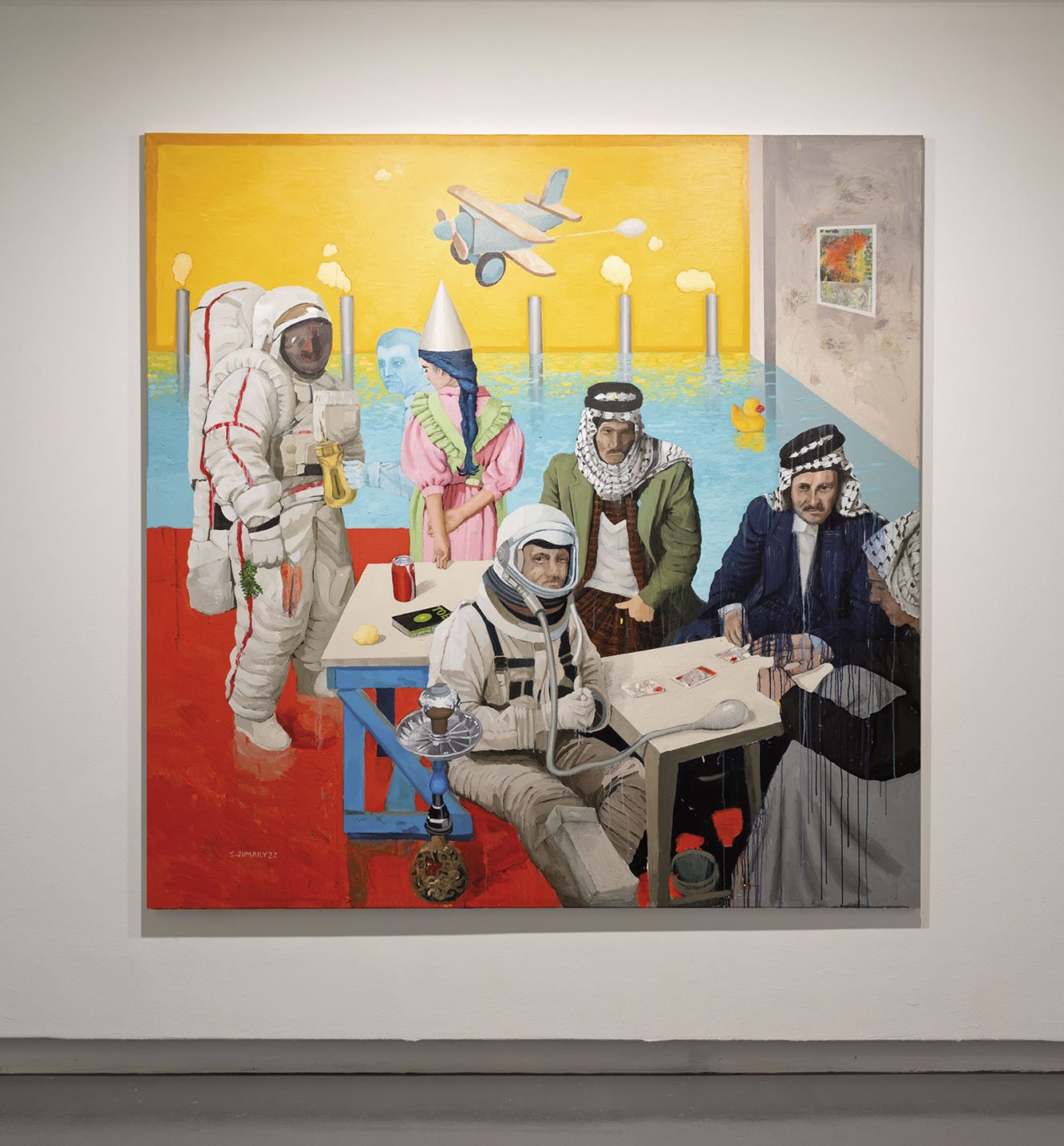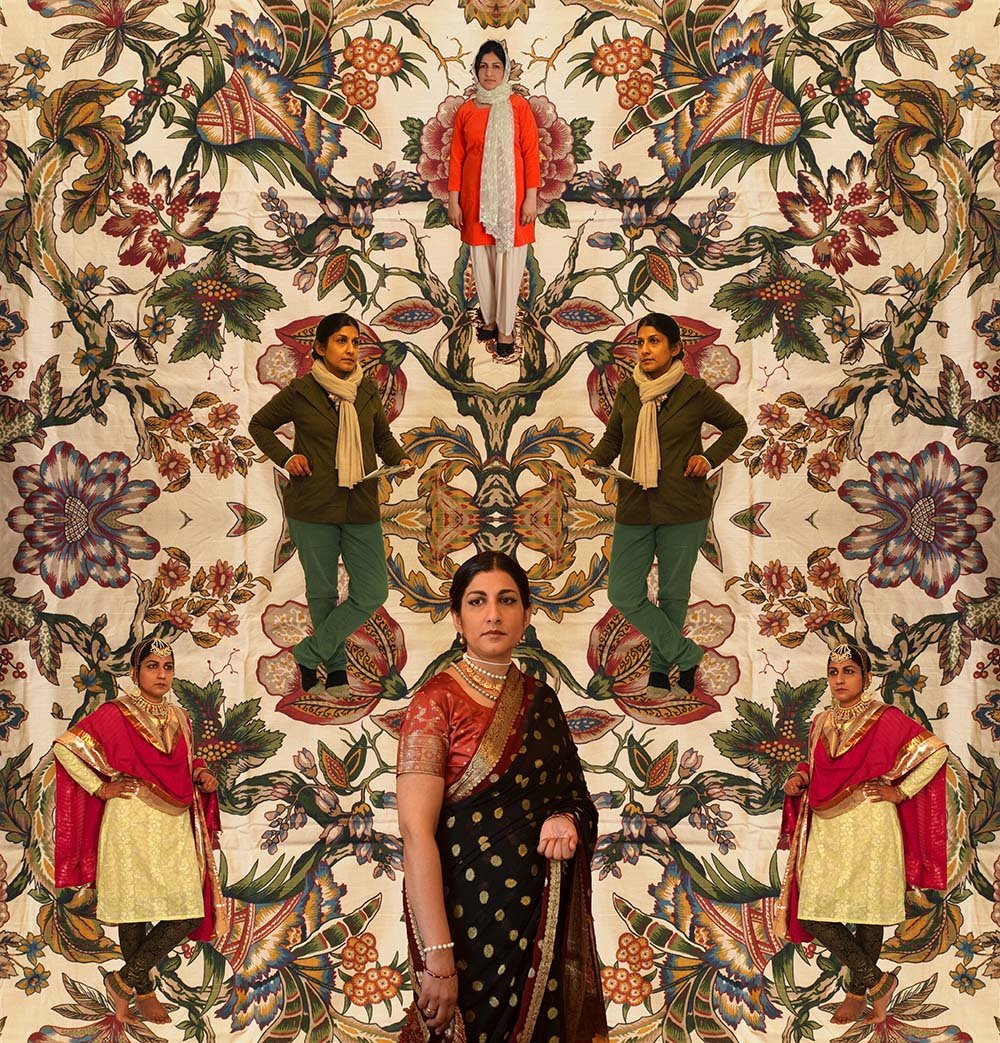Sharjah Biennial 15: Engines Of Meditation
With more than 300 works by over 150 artists and collectives from over 70 countries, Sharjah Biennial 15 opened in February 2023 with works ranging across topics but uniting in content.
This review was originally published in Hadara Magazine, March 2023
A Tale of Time and Purple Republic (2023) by Ghana’s Ibrahim Mahama. His practice grapples with globalisation, colonialism, injustice and trade. This is one of three pieces Mahama is showing at SB15. Photo: Ruksana Hussain.
Serving as a makeshift shade from the pervasive sunshine on Sharjah’s east coast, Ibrahim Mahama’s installation on the outer flank of Kalba Ice Factory had visitors squinting upward. A Tale of Time and Purple Republic (2023) is a convergence of several elements of the Ghanaian artist’s practice pulled together over much of the last decade. It consists of an 80 x 9 meter swathe of dark grey cloth, upon which traditional handwoven smock fabrics were sewn, the entire piece was then threaded through an enormous, purpose-built metal loom. Despite its almost overwhelming size, the artwork gave off a gentle presence as it caught the breeze coming from the nearby mangroves.
Viewers ponder its symbolism. The sometimes threadbare smocks adorning the larger cloth are traditionally passed down through generations and so, within their fibres, they hold the stories of decades. In assembling them in a single work upon new fabric, the artist is commenting on how identity is formed. On the one hand, we fashion ourselves on those who came before us, our inner selves woven by generations of tradition and culture that predate our existence. On the other, with modern travel or migration, our identities morph and wander depending on our paths. The work, a Sharjah Art Foundation commission, is one of three pieces Mahama is showing at Sharjah Biennial 15, which opened in February. His practice grapples with globalisation, colonialism, injustice and trade—themes that appear multiple times.
Spanning 19 venues and five cities and towns in Sharjah, the biennial underscores a message of togetherness, even if the stories presented are from the far corners of the world. Whether it is political turmoil in the Philippines, decades-long simmering tension in Palestine, the struggle of Maori women in New Zealand, or the challenge of exile, in all the stories we find solidarity.
“This biennial has no beginning and end. There is no direct route,” Sheikha Hoor Al Qasimi, president and director of Sharjah Art Foundation, said in her introduction. “I am interested in different viewpoints and it is very important that this biennial gives you many experiences and comes full circle with the same messages of power and solidarity, strength and friendship.”
Among 30 artists commissioned to make new work for SB15 is Colombian sculptor and artist Doris Salcedo. Uprooted (2020-2022) is made from more than 400 dead trees. The work is a testament to the refugee’s predicament: permanently impermanent. Photos: Juan Castro Photoholic. Courtesy of the artist.
Sharjah Biennial 15: Thinking Historically in the Present, was more than four years in the making. Originally slated for 2021, the event was suspended by the Covid-19 pandemic. Even more fraught was the loss of its mastermind, Okwui Enwezor, an influential Nigerian curator whose visionary work was aimed at shifting the gaze of Western art audiences towards the Global South. Enwezor died in 2019 at the age of 55 after a battle with cancer, and this biennial is his final work. Sheikha Hoor picked up the curatorial reins to realise Enwezor’s vision. This year is a notable one for her, too, marking two decades that she has been the biennial’s director. During the opening remarks for SB15, Sheikha Hoor paid tribute to Enwezor by reading from one of his text messages to her:
“I see the Sharjah Biennial as a unique model that grew from a biennial to institutionalisation, and the institution that emerged from that has provided a context of thinking and understanding about the pervasive challenges of art and the art worlds and cultural spheres from which art emerges. You also engaged deeply, in a manner that is not superficial, with the problems of understanding that often bedevil contemporary art. It’s a problem from which misunderstandings arise and in which blind spots persist, and for which you have built engines of mediation and historical, cultural, artistic, pedagogical, and discursive amelioration.”
The old ice factory in Kalba opened this year after renovation by Peru-based studio 51-1 Arquitectos, creating 20,000 square metres of exhibition space. One of its galleries houses Colombian artist Doris Salcedo’s unforgettable Uprooted (2020-2022). Made from 804 dead trees, it takes the form of a house at one end and dissolves into a forest of dead trees at the other. At once rootless and persistent, fragile yet strong, the work is a testament to the refugee’s predicament: permanently impermanent. It was one of three works awarded for outstanding contribution to the biennial. Another work in Kalba, Duty Colossus (2022) by Nari Ward, is constructed of long, roughly cut wooden panels. The monumental sculpture evokes the makeshift structure of Jamaican fishing villages but feels like a portal to another dimension.
Some of the settings couldn’t be more perfect for the artists’ messages. At an abandoned kindergarten in Kalba, for her work Threshold (2022), Afghan artist Hangama Amiri has hung swathes of black fabric—representing the garments women and girls are forced to wear by the Taliban regime—over school desks, symbolically telling the story of the artist, who was banned from formal education at the age of six by the Taliban.
Iraqi artist Saddam Al Jumaily’s Unfair Game (2022). His surrealist works deride the future for Iraqis in the chaos of a war-torn country. Photo: Shanavas Jamaluddin courtesy of Sharjah Art Foundation.
In Sharjah City, at the Sharjah Art Museum, stories of adversity play out from around the world. Robyn Kahukiwa, whose resistance paintings address power plays and the erasure of traditions in Maori culture in New Zealand, presents 50 years of her works. Jawad Al Malhi’s portraits of Jerusalem’s youth are as sapped of colour as his subjects are drained mentally and physically by their perpetual wait for change. Nearby, Saddam Al Jumaily’s surrealist works deride the future for Iraqis in the chaos of a war-torn country. Kimathi Donkor’s portrayal of the race riots between police and young British Black men in Brixton in the 1980s and Hiroji Kubota’s reportage on the Black Panther Party in 1960s US both remain poignant decades later. Varunika Saraf’s complex retelling of the histories of South Asia—maps sewn by hand, where words describe events of the past, some significant, others private memories—are delicate and strong.
Much of the biennial, even when not talk-ing of real events, explores the relationship between past and present, closely linked with the biennial’s title, which was taken from Enwezor’s discussions about time and memory in a post-colonial world. In a former swimming pool at Sheikh Khalid bin Mohammed Palace in Al Dhaid, Kader Attia’s installation, Le Grand Miroir du Monde [the great mirror of the world] (2017) uses thousands of shards of mirrored glass to reflect an “eternal present” that overshadows memories of the past. In Bait Al Serkal, for her work The Myth of Eternal Life (2020-2022), Zohra Opoku explores the dichotomy between the solid yet fleeting nature of life with a work resembling a papyrus scroll, made at a weaving factory in Senegal. In it, she links ancient Egyptian funeral practices with her own healing journey from illness. In Khorfakkan Art Centre, Emirati artist Farah Al Qasimi’s project, a film about the ghost of a pirate who died defending Ras Al Khaimah in a siege and told by a genie (or jinn) known as Umm Al Dhabab (Mother of Fog), embraces myth whilst also pointing to the inescapability of the past.
Nusra Latif Qureshi, The Ideal Floral Background (2013). Qureshi references the traditional art of South Asian miniature painting in her art practice. Her practice ranges from small and highly detailed paintings to large scale digital prints that engage with the visual histories of the South Asian region. Photo: Courtesy of the artist and Sutton Gallery, Melbourne
In Bait Obaid Al Shamsi, Shiraz Bayjoo also ventures into tales of pirate kingdoms with his installation Searching for Libertalia (2019), exploring the process of African independence in the context of Daniel Defoe’s 1724 book about the history of pirates. “I am thinking about the cycle of history,” says the Mauritian artist, who is participating in the biennial for the second time. “My practice explores unionism versus independence and the ongoing nature of that. It tries to open up the layers of these narratives that have not been told from this viewpoint before.”
Retelling history through the eyes of those who have experienced it and reclaiming a past that is lost in time is the overarching message of this biennial. Within each sensitively curated presentation, miniature stories unfold into one another.
“Foregrounding emergent, primarily non- Western institutional practices and priorities, the ethos of Sharjah Biennial is pluricentric and polyphonic and therefore calls for non-traditional modes of curation,” Sheikha Hoor writes in her curatorial essay. It is a statement of who she has become as a curator, and how she has positioned Sharjah as a place for cultural exchange and intersection that not only attracts the international art world but continually engages the local community.
Sharjah Biennial 15: February 7 to June 11, 2023




